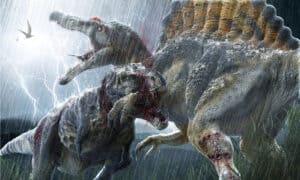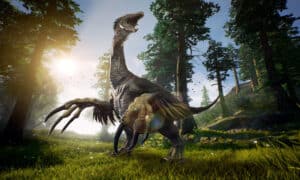With over 900 genera of non-avian dinosaurs officially named thus far, there are dinos that start with every letter of the alphabet. This includes over three dozen dinosaurs that start with K. Read on to learn all their names and what they mean!
1. Kaatedocus
Name means: “small beam”
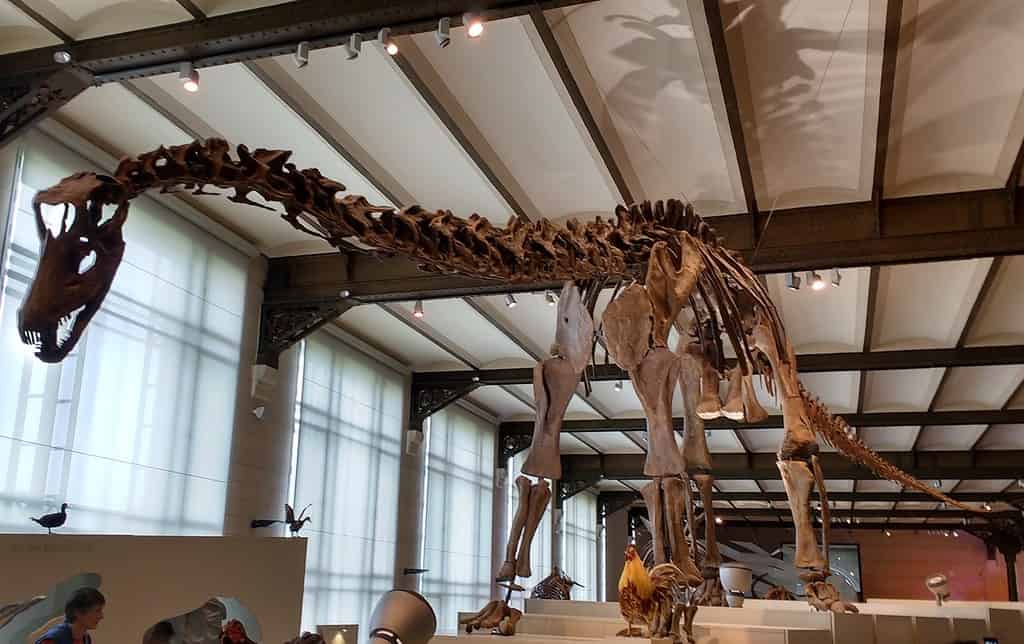
was an herbivore.
©Fernando Losada Rodríguez / CC BY-SA 4.0 – License
Kaatedocus is a genus of diplodocoid from the Late Jurassic. Researchers named the type species Kaatedocus siberi in 2012 from fossils found in Wyoming, USA.
2. Kaijiangosaurus
Name means: “Kaijiang lizard”
Kaijiangosaurus is a genus of tetanuran from the Middle Jurassic. Researchers named the type species Kaijiangosaurus lini in 1984 from fossils found in China.
3. Kaijutitan
Name means: “Kaiju titan”
Kaijutitan is a genus of titanosaur from the Late Cretaceous. Researchers named the type species Kaijutitan maui in 2019 from fossils found in Argentina.
4. Kakuru
Name means: named after the Rainbow Serpent
Kakuru is a genus of maniraptor from the Early Cretaceous. Researchers named the type species Kakuru kujani in 1980 from fossils found in Australia.
5. Kamuysaurus
Name means: “deity lizard”
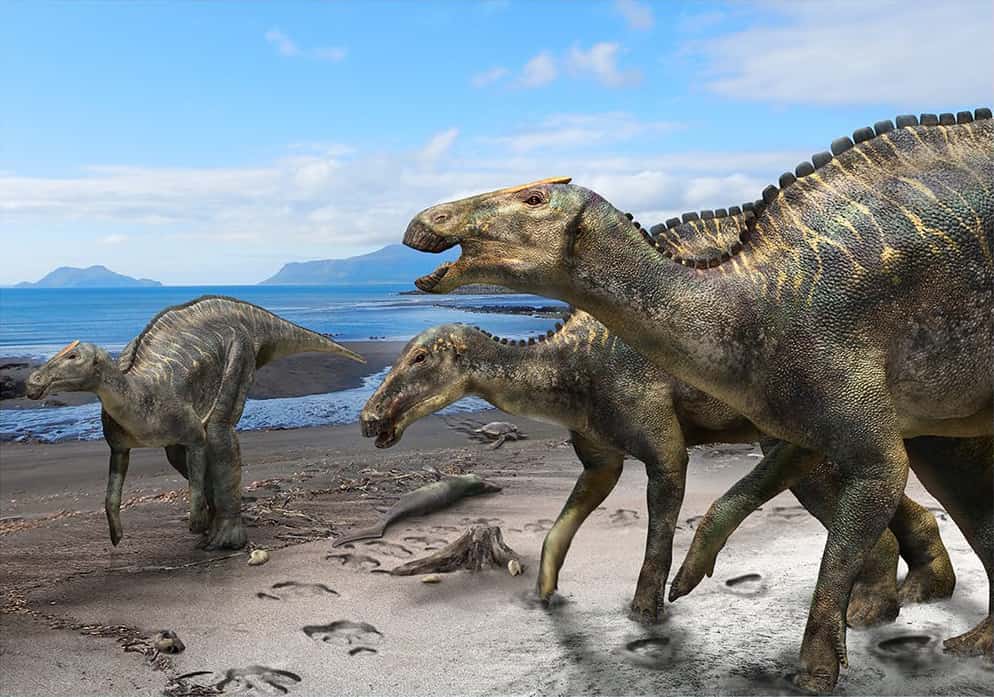
was an herbivore.
©Art by Masato Hattori, published by Yoshitsugu Kobayashi, Tomohiro Nishimura, Ryuji Takasaki, Kentaro Chiba, Anthony R. Fiorillo, Kohei Tanaka, Tsogtbaatar Chinzorig, Tamaki Sato & Kazuhiko Sakurai / CC BY 4.0 – License
Kamuysaurus is a genus of saurolophine hadrosaur from the Late Cretaceous. Researchers named the type species Kamuysaurus japonicus in 2019 from fossils found in Japan.
6. Kangnasaurus
Name means: “Kangna Farm lizard”
Kangnasaurus is a genus of dryosaur from the Early Cretaceous. Researchers named the type species Kangnasaurus coetzeei in 1915 from fossils found in South Africa.
7. Kansaignathus
Name means: “Kansai jaw”
Kansaignathus is a genus of dromaeosaur from the Late Cretaceous. Researchers named the type species Kansaignathus sogdianus in 2021 from fossils found in Tajikistan.
8. Karongasaurus
Name means: “Karonga lizard”
Karongasaurus is a genus of titanosaur from the Early Cretaceous. Researchers named the type species Karongasaurus gittelmani in 2005 from fossils found in Malawi.
9. Katepensaurus
Name means: “hole lizard”
Katepensaurus is a genus of rebbachisaur from the Late Cretaceous. Researchers named the type species Katepensaurus goicoecheai in 2013 from fossils found in Argentina.
10. Kayentavenator
Name means: “Kayenta hunter”
Kayentavenator is a genus of tetanuran from the Early Jurassic. Researchers named the type species Kayentavenator elysiae in 2010 from fossils found in Arizona, USA.
11. Kazaklambia
Name means: “Kazakh lambeosaurine”
Kazaklambia is a genus of lambeosaurine hadrosaur from the Late Cretaceous. Researchers named the type species Kazaklambia convincens in 1968 from fossils found in Kazakhstan.
12. Kelmayisaurus
Name means: “Karamay lizard”
Kelmayisaurus is a genus of carcharodontosaur from the Early Cretaceous. Researchers named the type species Kelmayisaurus petrolicus in 1973 from fossils found in China.
13. Kelumapusaura
Name means: “red earth lizard”
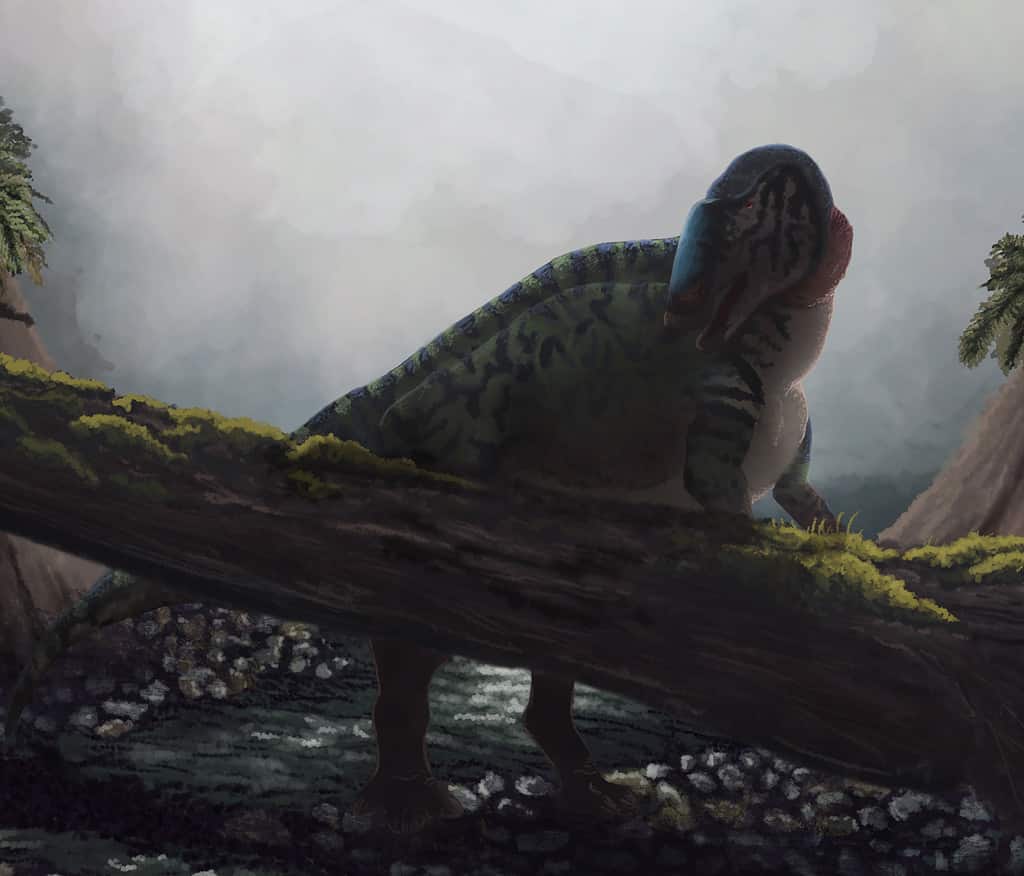
was an herbivore.
©Leonardo HerSan / CC BY-SA 4.0 – License
Kelumapusaura is a genus of saurolophine hadrosaur from the Late Cretaceous. Researchers named the type species Kelumapusaura machi in 2022 from fossils found in Argentina.
14. Kentrosaurus
Name means: “spike lizard”
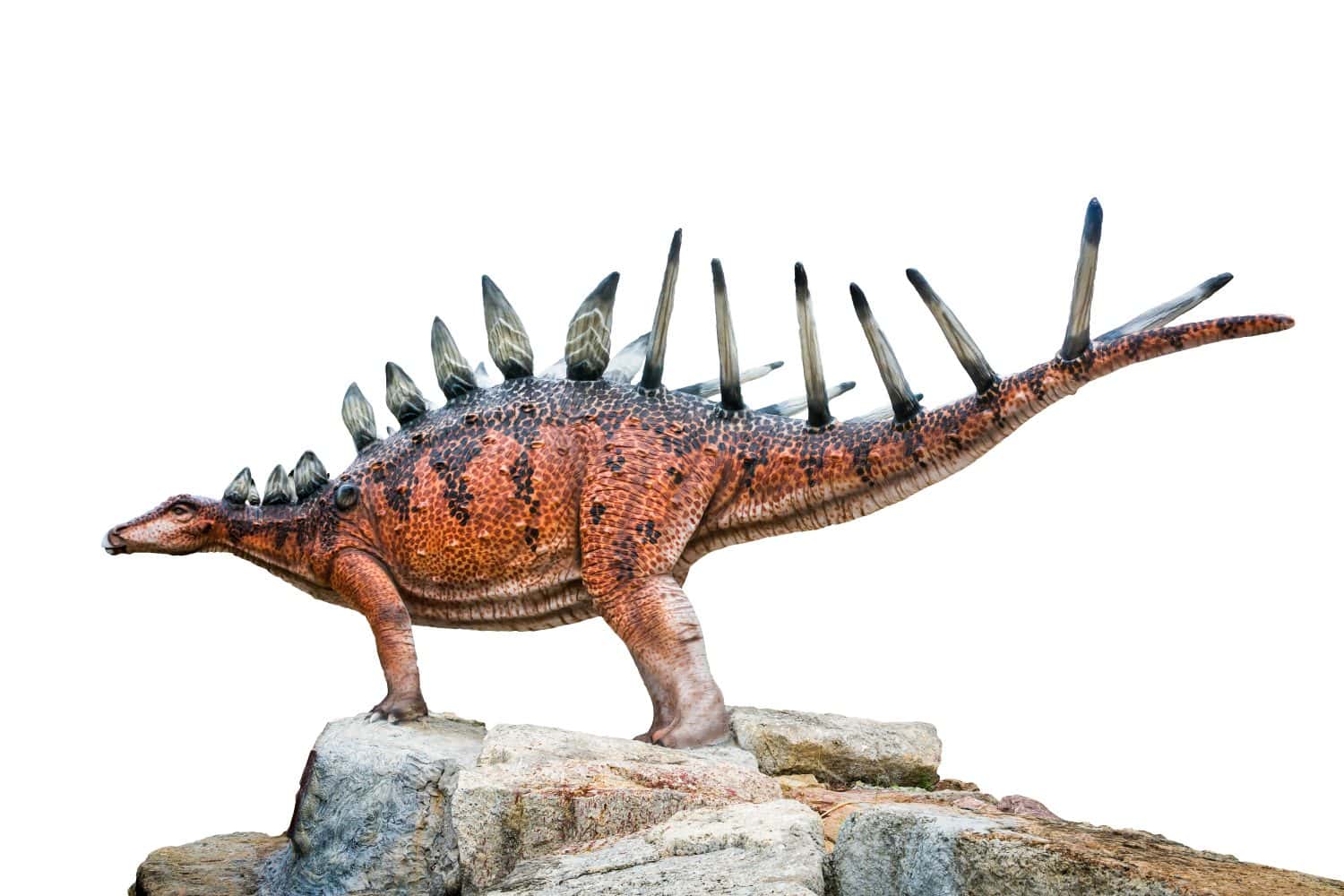
was an herbivore.
©YuRi Photolife/Shutterstock.com
Kentrosaurus is a genus of stegosaur from the Late Jurassic. Researchers named the type species Kentrosaurus aethiopicus in 1915 from fossils found in Tanzania.
15. Kerberosaurus
Name means: “Kerberos lizard”
Kerberosaurus is a genus of saurolophine hadrosaur from the Late Cretaceous. Researchers named the type species Kerberosaurus manakini in 2004 from fossils found in Russia.
16. Khaan
Name means: “Lord”
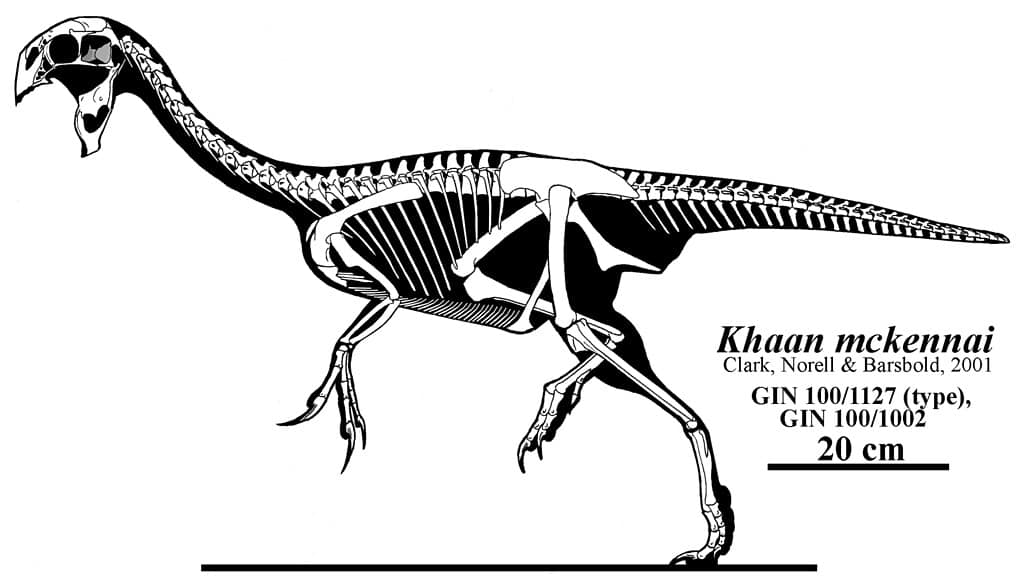
may have been an omnivore.
©Jaime A. Headden (User:Qilong) / CC BY 3.0 – License
Khaan is a genus of oviraptor from the Late Cretaceous. Researchers named the type species Khaan mckennai in 2001 from fossils found in Mongolia.
17. Kholumolumo
Name means: derived from a type of dragon in Sotho mythology
Kholumolumo is a genus of massopod from the Late Triassic. Researchers named the type species Kholumolumo ellenbergerorum in 2020 from fossils found in Lesotho.
18. Khulsanurus
Name means: “Khulsan tail”
Khulsanurus is a genus of alvarezsaur from the Late Cretaceous. Researchers named the type species Khulsanurus magnificus in 2021 from fossils found in Mongolia.
19. Kileskus
Name means: “lizard”
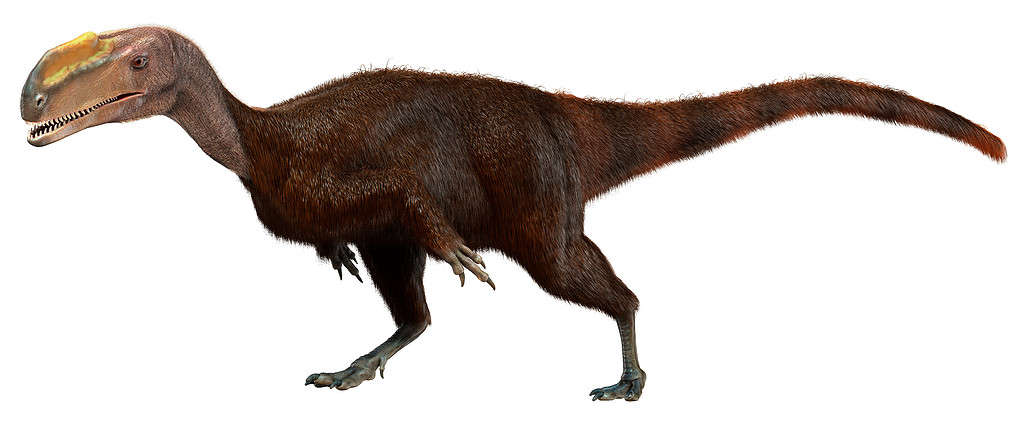
was a carnivore.
©Пётр Меньшиков / CC BY-SA 4.0 – License
Kileskus is a genus of tyrannosauroid from the Middle Jurassic. Researchers named the type species Kileskus aristotocus in 2010 from fossils found in Russia.
20. Kinnareemimus
Name means: “Kinnaree mimic”
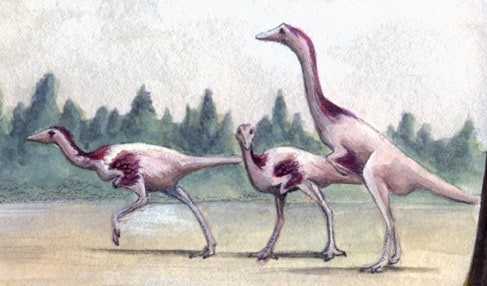
may have been an omnivore.
©Renata Cunha, Marcos A. F. Sales, Marcel B. Lacerda, Bruno L. D. Horn, Isabel A. P. de Oliveira, Cesar L. Schultz / CC BY-SA 4.0 – License
Kinnareemimus is a genus of ornithomimosaur from the Early Cretaceous. Researchers named the type species Early Cretaceous in 2009 from fossils found in Thailand.
21. Klamelisaurus
Name means: “Klameli Mountains lizard”
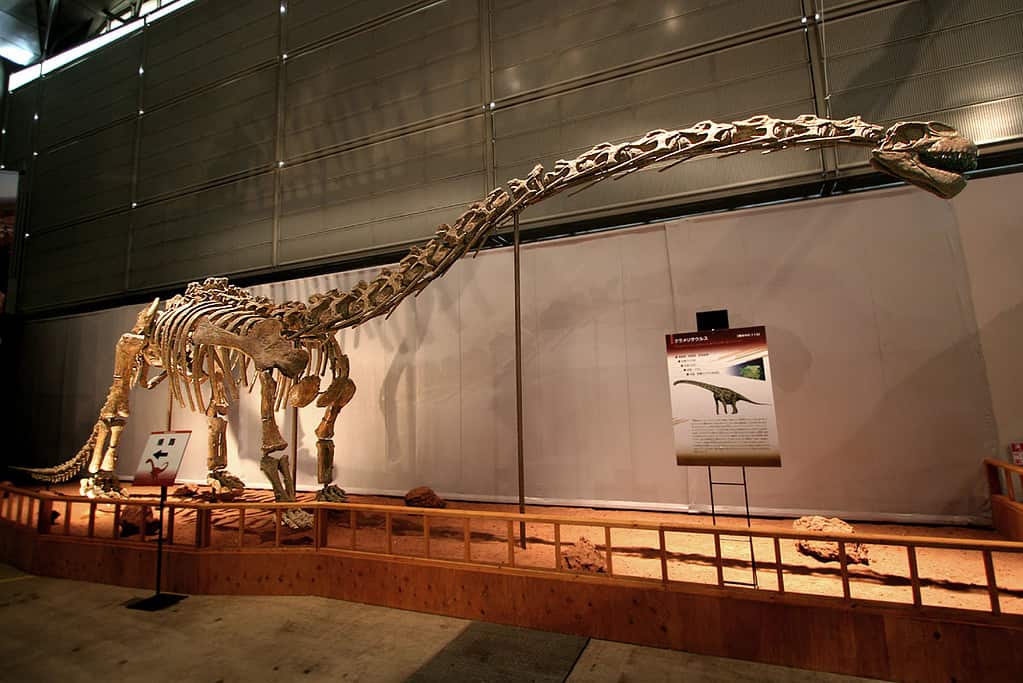
was an herbivore.
©Kabacchi / CC BY 2.0 – License
Klamelisaurus is a genus of mamenchisaur from the Middle Jurassic. Researchers named the type species Kinnareemimus khonkaenensis in 1993 from fossils found in China.
22. Kol
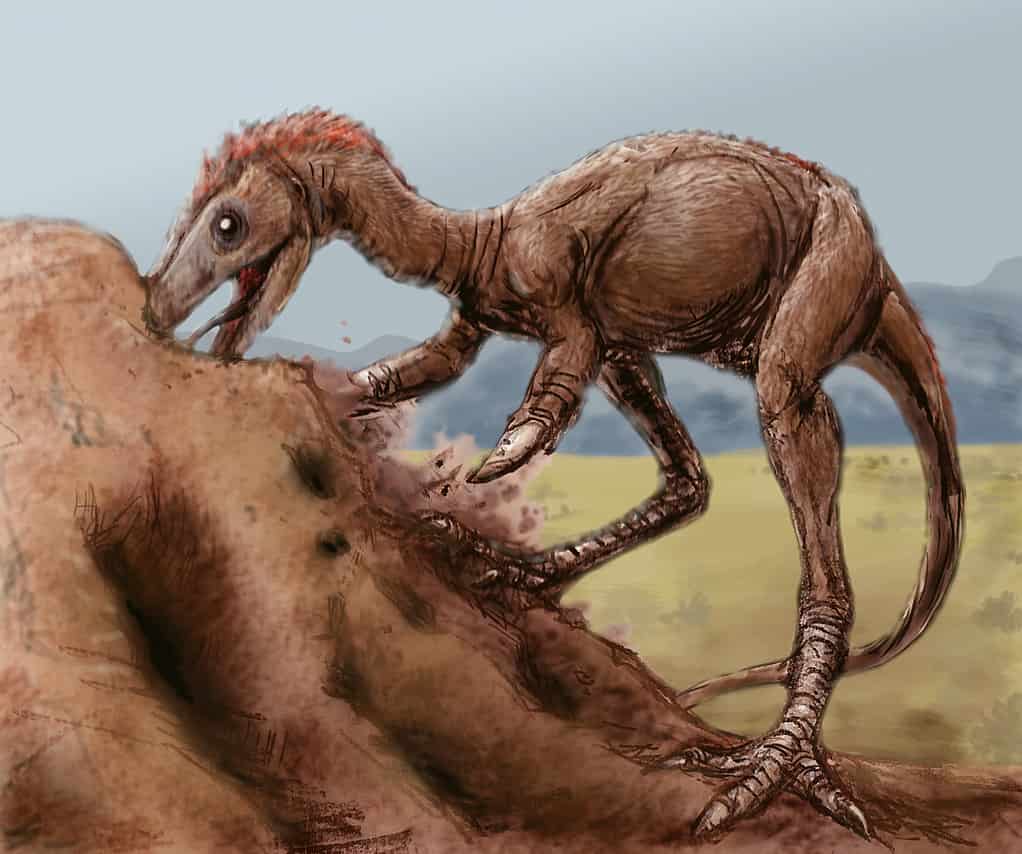
may have been an insectivore.
©FunkMonk (Michael B. H.) / CC BY-SA 3.0 – License
Name means: “foot”
Kol is a genus of coelurosaur from the Late Cretaceous. Researchers named the type species Kol ghuva in 2009 from fossils found in Mongolia.
23. Koparion
Name means: an ancient type of small surgical knife (scalpel)
Koparion is a genus of coelurosaur from the Late Jurassic. Researchers named the type species Koparion douglassi in 1994 from fossils found in Utah, USA.
24. Koreaceratops
Name means: “Korean horned face”

was an herbivore.
©YuRi Photolife/Shutterstock.com
Koreaceratops is a genus of ceratopsian from the Early Cretaceous. Researchers named the type species Koreaceratops hwaseongensis in 2011 from fossils found in South Korea.
25. Koreanosaurus
Name means: “Korean lizard”
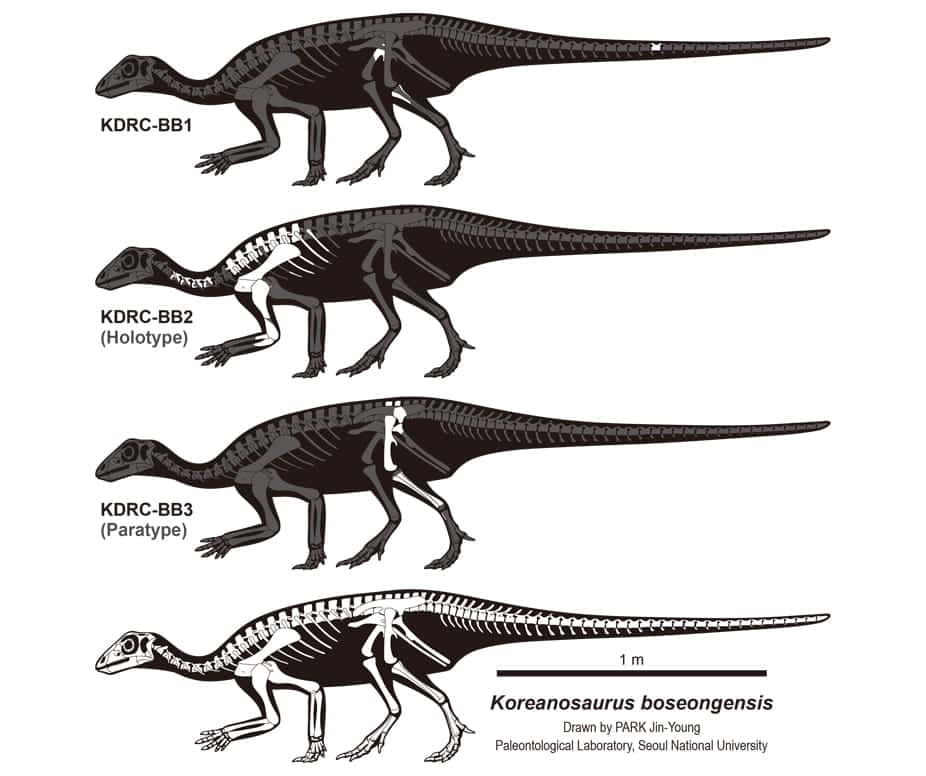
was an herbivore.
©PARK Jin-Young / CC BY 4.0 – License
Koreanosaurus is a genus of orodromine from the Late Cretaceous. Researchers named the type species Koreanosaurus boseongensis in 2011 from fossils found in South Korea.
26. Koshisaurus
Name means: “Koshi lizard”
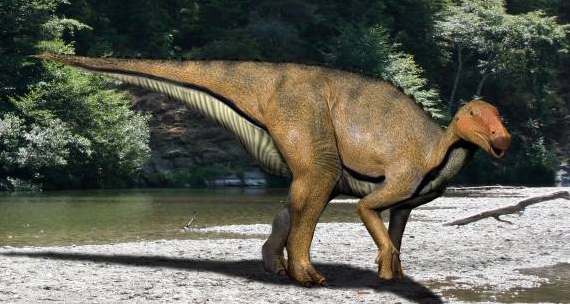
was an herbivore.
©Nobu Tamura / CC BY-SA 4.0 – License
Koshisaurus is a genus of hadrosauroid from the Early Cretaceous. Researchers named the type species Koshisaurus katsuyama in 2015 from fossils found in Japan.
27. Kosmoceratops
Name means: “ornate horned face”

was an herbivore.
©YuRi Photolife/Shutterstock.com
Kosmoceratops is a genus of ceratopsian from the Late Cretaceous. Researchers named the type species Kosmoceratops richardsoni in 2010 from fossils found in Utah, USA.
28. Kotasaurus
Name means: “Kota Formation lizard”
Kotasaurus is a genus of eusauropod from the Early Jurassic. Researchers named the type species Kotasaurus yamanpalliensis in 1988 from fossils found in India.
29. Koutalisaurus
Name means: “spoon lizard”
Koutalisaurus is a genus of lambeosaurine hadrosaur from the Late Cretaceous. Researchers named the type species Koutalisaurus kohlerorum in 2006 from fossils found in Spain.
30. Kritosaurus
Name means: “separated lizard”
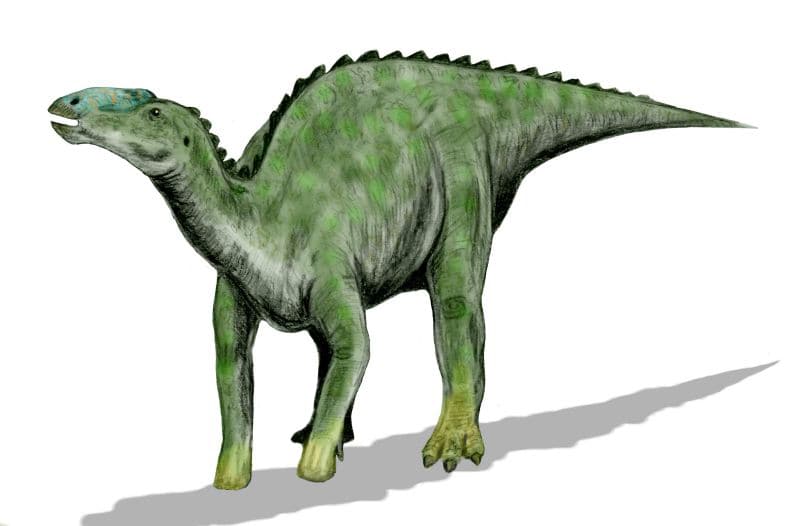
was an herbivore.
©Nobu Tamura (http://spinops.blogspot.com) / CC BY-SA 3.0 – License
Kritosaurus is a genus of saurolophine hadrosaur from the Late Cretaceous. Researchers named the type species Kritosaurus navajovius in 1910 from fossils found in New Mexico, USA.
31. Kryptops
Name means: “covered face”
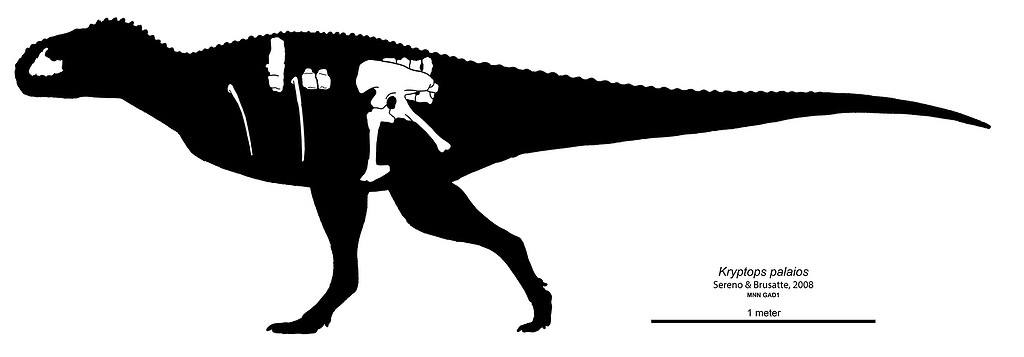
was a carnivore.
©Paleocolour / CC BY-SA 4.0 – License
Krytops is a genus of abelisaur from the Early Cretaceous. Researchers named the type species Kryptops palaios in 2008 from fossils found in Niger.
32. Kulceratops
Name means: “[Khodzha]kul horned face”
Kulceratops is a genus of ceratopsian from the Early Cretaceous. Researchers named the type species Kulceratops kulensis in 1995 from fossils found in Uzbekistan.
33. Kulindadromeus
Name means: “Kulinda runner”
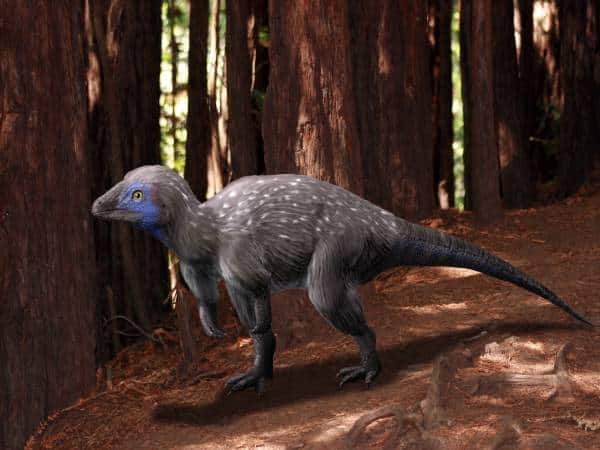
was an herbivore.
©Nobu Tamura email:[email protected] http://spinops.blogspot.com/ / CC BY-SA 4.0 – License
Kulindadromeus is a genus of neornithischian from the Middle Jurassic. Researchers named the type species Kulindadromeus zabaikalicus in 2014 from fossils found in Russia.
34. Kunbarrasaurus
Name means: “shield lizard”

was a herbivore.
©Cas Liber / CC0 – License
Kunbarrasaurus is a genus of ankylosaur from the Early Cretaceous. Researchers named the type species Kunbarrasaurus ieversi in 2015 from fossils found in Australia.
35. Kundurosaurus
Name means: “Kundur lizard”
Kundurosaurus is a genus of saurolophine hadrosaur from the Late Cretaceous. Researchers named the type species Kundurosaurus nagornyi in 2012 from fossils found in Russia.
36. Kuru
Name means: named after Kurukullā (Tibetan Buddhist deity)

was a carnivore.
©UnexpectedDinoLesson / CC BY-SA 4.0 – License
Kuru is a genus of dromaeosaur from the Late Cretaceous. Researchers named the type species Kuru kulla in 2021 from fossils found in Mongolia.
37. Kurupi
Name means: named for a fertility god from Guaraní mythology
Kurupi is a genus of abelisaur from the Late Cretaceous. Researchers named the type species Kurupi itaata in 2021 from fossils found in Brazil.
Summary of 37 Dinosaurs That Start With K
| Name | Meaning | Geological Period | Where Found | Year Named |
|---|---|---|---|---|
| 1. Kaatedocus | “small beam” | Late Jurassic | Wyoming, USA | 2012 |
| 2. Kaijiangosaurus | “Kaijiang lizard” | Middle Jurassic | China | 1984 |
| 3. Kaijutitan | “Kaiju titan” | Late Cretaceous | Argentina | 2019 |
| 4. Kakuru | named after the Rainbow Serpent | Early Cretaceous | Australia | 1980 |
| 5. Kamuysaurus | “deity lizard” | Late Cretaceous | Japan | 2019 |
| 6. Kangnasaurus | “Kangna Farm lizard” | Early Cretaceous | South Africa | 1915 |
| 7. Kansaignathus | “Kansai jaw” | Late Cretaceous | Tajikistan | 2021 |
| 8. Karongasaurus | “Karonga lizard” | Early Cretaceous | Malawi | 2005 |
| 9. Katepensaurus | “hole lizard” | Late Cretaceous | Argentina | 2013 |
| 10. Kayentavenator | “Kayenta hunter” | Early Jurassic | Arizona | 2010 |
| 11. Kazaklambia | “Kazakh lambeosaurine” | Late Cretaceous | Kazakhstan | 1968 |
| 12. Kelmayisaurus | “Karamay lizard” | Early Cretaceous | China | 1973 |
| 13. Kelumapusaura | “red earth lizard” | Late Cretaceous | Argentina | 2022 |
| 14. Kentrosaurus | “spike lizard” | Late Jurassic | Tanzania | 1915 |
| 15. Kerberosaurus | “Kerberos lizard” | Late Cretaceous | Russia | 2004 |
| 16. Khaan | “Lord” | Late Cretaceous | Mongolia | 2001 |
| 17. Kholumolumo | derived from a type of dragon in Sotho mythology | Late Triassic | Lesotho | 2020 |
| 18. Khulsanurus | “Khulsan tail” | Late Cretaceous | Mongolia | 2021 |
| 19. Kileskus | “lizard” | Middle Jurassic | Russia | 2010 |
| 20. Kinnareemimus | “Kinnaree mimic” | Early Cretaceous | Thailand | 2009 |
| 21. Klamelisaurus | Klameli Mountains lizard” | Middle Jurassic | China | 1993 |
| 22. Kol | “foot” | Late Cretaceous | Mongolia | 2009 |
| 23. Koparion | an ancient type of small surgical knife (scalpel) | Late Jurassic | Utah, USA | 1994 |
| 24. Koreaceratops | “Korean horned face” | Early Cretaceous | South Korea | 2021 |
| 25. Koreanosaurus | “Korean lizard” | Late Cretaceous | South Korea | 2021 |
| 26. Koshisaurus | “Koshi lizard” | Early Cretaceous | Japan | 2015 |
| 27. Kosmoceratops | “ornate horned face” | Late Cretaceous | Utah, USA | 2010 |
| 28. Kotasaurus | “Kota Formation lizard” | Early Jurassic | India | 1988 |
| 29. Koutalisaurus | “spoon lizard” | Late Cretaceous | Spain | 2006 |
| 30. Kritosaurus | “separated lizard” | Late Cretaceous | New Mexico, USA | 1910 |
| 31. Kryptops | “covered face” | Early Cretaceous | Niger | 2008 |
| 32. Kulceratops | “[Khodzha]kul horned face” | Early Cretaceous | Uzbekistan | 1995 |
| 33. Kulindadromeus | “Kulinda runner” | Middle Jurassic | Russia | 2014 |
| 34. Kunbarrasaurus | “shield lizard” | Early Cretaceous | Australia | 2015 |
| 35. Kundurosaurus | “Kundur lizard” | Late Cretaceous | Russia | 2012 |
| 36. Kuru | named after Kurukullā (Tibetan Buddhist deity) | Late Cretaceous | Mongolia | 2021 |
| 37. Kurupi | named for a fertility god from Guaraní mythology | Late Cretaceous | Brazil | 2021 |
The photo featured at the top of this post is © Daniel Eskridge from Getty Images, / via Canva.com
Thank you for reading! Have some feedback for us? Contact the AZ Animals editorial team.



